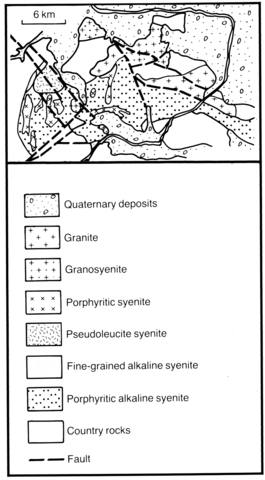stripes
This occurrence is situated in the central part of the northern Tyan-Shan to the west of Lake Issyk-Kul. It is a large, elongate, complex body, trianglular in plan with an area of about 350 km2. It is emplaced into Palaeozoic schists and sandstones and Permian extrusive rocks and is composed of the rocks of three intrusive phases, the first of which is alkaline. Among the rocks of the first phase four sub-phases can be distinguished. The first of these consists of porphyritic quartz-bearing and peralkaline syenites (pulaskites). The main rock-forming minerals of these rocks are orthoclase, andesine, diopside, biotite, alkali amphibole and sometimes quartz; accessories are apatite, titanite, titanomagnetite and zircon. During the second sub-phase small bodies of leucocratic syenite were intruded the principal minerals of which are orthoclase, andesine, diopside, amphibole and more rarely quartz. During the third sub-phase small volumes of nepheline and pseudoleucite syenites were emplaced. The nepheline syenites are composed of orthoclase, diopside, amphibole, biotite and nepheline, which is restricted to the mesostasis. The pseudoleucite syenites contain phenocrysts of nepheline, pseduoleucite and barkevikite in a groundmass of orthoclase, nepheline, barkevikite, biotite, diopside and a little olivine. The accessories are titanite, apatite, zircon, titanomagnetite, fluorite and pyrite. The fourth subphase is represented by evenly textured biotite quartz-bearing syenites which form small, vein-like bodies. The syenite intrusions are crossed by numerous dykes and veins of lamprophyre, monzonite, syenite, granite and aplite. The second major intrusive phase consists of granosyenites, which contain biotite and amphibole, while the third phase comprises granites with biotite only.
DODONOVA, T.A., POMAZKOV, K.D. and POMAZKOV, Ya.K. 1984. Endogenic magmatic formations of Kirgizia. 1: 152-9. Ilim, Frunze.
GAVRILIN, R.D. 1964. Geological composition of the complex syenite-granite massif of Kyzyl-Ompul (North Tyan-Shan). Izvestiya Akademii Nauk SSSR. Geological Series, 3: 69-83.
IZRAILEVA, P.M. and TUROVSKY, S.D. 1958. The Ortotokoisky massif of giant-grained and giant-porphyritic syenites. Guidebook around North Kirgizia. Trudy of the 2nd Petrographical Conference. Academy of Sciences, Kirgiz SSR. Frunze. 11-25.

